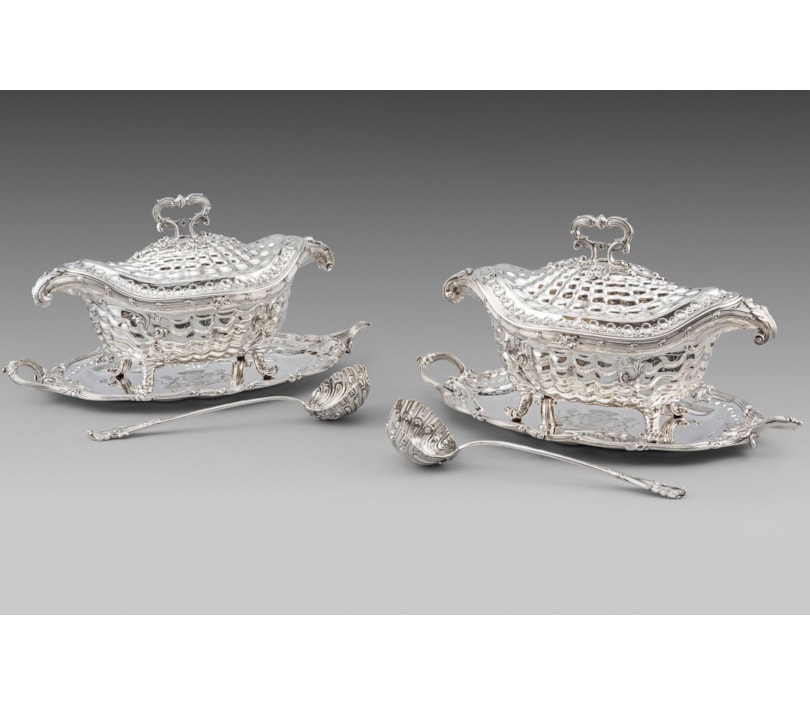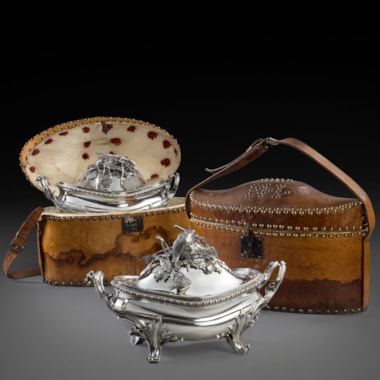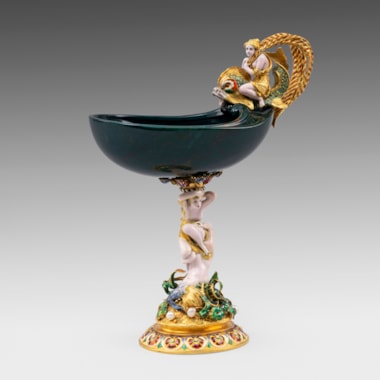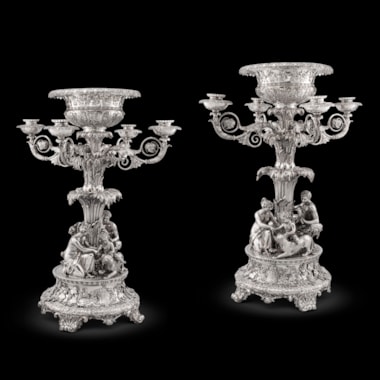Each tureen of oval shape and on four quilted scroll feet, with beaded ribbon-tied reeded borders interspersed with acanthus. The tureens chased overall with a wave and scroll pattern with foliage-capped scroll handles. The conforming cover quilted and with beaded scroll and guilloche border together with beaded foliate scroll handle. The plain liner with scroll handles and strengthening panels, the stands each shaped oval with beaded foliage wrapped reeded border and two handles, with inner beaded border. The ladles each with shell bowl, scroll and shell heel, reeded stem and foliage-wrapped terminal, the stands engraved with a coat-of-arms, the ladles engraved with a crest.
Marked on stands, tureens, covers and ladles, the stands also engraved with number and scratchweight 'No=1 84=13', 'No=2 83=19'; the tureens engraved 'No=1 165=9' and 'No=2 166=13'; the covers engraved 'No=1' and 'No 2'; and one liner engraved twice 'No 2'
The 9th Earl succeeded his father in 1754. He made many contributions to the fabric and to the collections of Burghley and completed work on a range of rooms started by the 5th Earl, which had lain unfinished since the latter's death in 1700. He commissioned Capability Brown to make improvements to the park and house and ordered great quantities of silver as well as the finest furniture from Ince and Mayhew, and Newton and Fell. In addition, he bought pictures and works of art in Italy and commissioned paintings from the leading artists of the day such as Angelica Kauffman R.A.
The following entry is recorded in the Wakelin Gentlemen's Ledgers, now in the Victoria & Albert Museum London:'9 Dec.31, 1756,
To 2 Terrines and dishes 500oz. 14dwts. at 11/1 - £277-9-6.
To 2 soup ladles 23oz. 18dwts. at 9/1 - £10-7-0.
To Graving 2 Coats and Supps. and 6 Crests and Corts £2-8-0.'
Included in the same commission was a magnificent centrepiece and plateau which, together with the present tureens, formed a small part of an immense commission. The Earl of Exeter is recorded as having ordered over 5,000 ounces of silver and silver-gilt from Wickes and Netherton in the mid 1750s. Some remains at Burghley. A set of six sugar-vases, now gilded, with domed covers and strawberry finials, are illustrated in, Burghley House, Silver Exhibition, exhibition catalogue, 1984, no. 65.
His choice of goldsmith is not surprising as George Wickes and Samuel Netherton were among the leading goldsmiths and retailers of the 18th century. Wickes entered his first mark in 1721. In 1735 he moved to Panton Street where he traded independently, having before been in partnership with John Craig. It was then as goldsmith to Frederick, Prince of Wales, that his business flourished. Samuel Netherton joined him as an apprentice in 1737. Edward Wakelin, who had been apprenticed to John le Sage was working for Wickes by this date. Wakelin organised a workshop of some eight to thirteen men and was in many ways an independent agent marking pieces with his own mark as seen here. Samuel Netherton became Wickes' partner in 1750 and it was not until both Wickes and Netherton retired in 1760 that Wakelin became a partner with Netherton's cousin, Wickes' last apprentice, John Parker. They continued the business with great success, with over 270 clients. When Parker and Wakelin retired in 1776 they passed the business on to Wakelin's son John and William Taylor who had been with the company since 1769. On Taylor's death in 1792 John Wakelin took on Robert Garrard as a partner and when John Wakelin himself died in 1802 the firm became under sole control of Garrard, whose name the company bears to this day. (for further details see E. Barr, George Wickes, Royal Goldsmith 1698-1761, London, 1980).
Supplied to Brownlow, 9th Earl of Exeter (1725-1793), 31 December 1756 by Messrs. George Wickes and Samuel Netherton for £290 4s 6d, and thence by descent to
The Marquess of Exeter; Christie's London, 17 July 1959, lot 69
Mrs Fay Plohn; Sotheby's New York, 16 July 1970, lot 106
Charles Engelhard+; Christie's London, 5 July 1972, lot 88
A. Grimwade, 'Silver at Althorp II', The Connoisseur, March 1963, p. 162
A. Grimwade, Rococo Silver, London, 1974, p. 43 pl. 29
E. Barr, George Wickes, Royal Goldmsith, 1698-1761, London, 1980, p. 204, fig. 123
M. Clayton, The Collector's Dictionary of the Silver and Gold of Great Britain and North America, Woodbridge, second edition, 1985, p. 364, no. 538
V. Brett, The Sotheby's Dictionary of Silver, London, 1986, no. 861
The Glory of the Goldsmith, Magnificent Gold and Silver from the Al-Tajir Collection, London, 1989, no.100, p.138
You May Also Like








































































